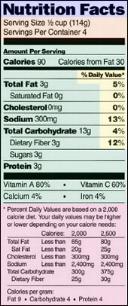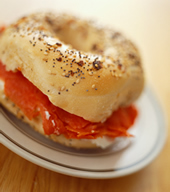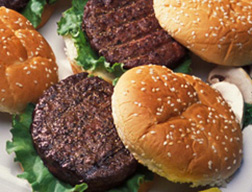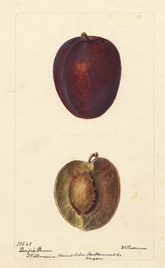| January 2007 |
|
|
PEA POD Gently Notes Baby's Fat
Better guidelines for determining if a baby's weight gains are healthful may emerge from studies using an air-displacement device known as a PEA POD. Weight gains early in life—especially weight gained as fat instead of bone and muscle—may be a predictor of a child's risk of developing heart disease, diabetes, or other chronic diseases in later years, studies have suggested.
For that reason, investigators at the ARS-funded Children's Nutrition Research Center, Houston, Texas, want to develop science-based growth charts for infants. The charts would be based on estimates of an infant's ratio of fat to lean tissue, called "body composition." This ratio is thought to be a better indicator of overall health and growth than height and weight tables.
Right now, there are no body composition standards for children under 2 years.
The PEA POD device, made by Life Measurement, Inc., Concord, Calif., may help the researchers gather needed statistics about changes in the amounts of fat and lean tissue during normal growth. Until now, scientists had to take measurements with a total of four different instruments to estimate an infant's body composition—a process that takes 3 to 4 hours. PEA POD readings take less than 5 minutes and are safe and painless.
Results from Children's Nutrition Research Center tests of 54 healthy babies indicate that PEA POD measurements are accurate to within about 1 percent (American Journal of Clinical Nutrition, volume 85, pages 90 to 95).
For details, contact: Kenneth J. Ellis, (713) 798-7131; USDA-ARS Children's Nutrition Research Center, Houston, Texas.
|
|
Middle-Schoolers Can Master Food-Label Lingo
Middle-school children are capable of understanding nutrition labels printed on the packaging of many foods, a study at the Children's Nutrition Research Center, Houston, Texas, indicates (Journal of the American Dietetic Association, volume 106, pages 913 to 916).
After about a half-hour of training with a small group of their peers, 34 volunteers age 11 to 14 were able to knowledgeably compare serving sizes, fat content, and other information on labels of familiar foods such as yogurt, cookies, pizza, and potato chips.
Now researchers want to determine if the training leads youngsters to make healthier food choices. Better choices are needed: Obesity rates have doubled in the past two decades for kids in this age range.
For details, contact: Keli M. Hawthorne, (713) 798-7085; USDA-ARS Children's Nutrition Research Center at Baylor College of Medicine, Houston, Texas.
Blueberry Compound Shows Cancer-Fighting Promise
|
|
Blueberries and grapes that contain a compound with the tongue-twisting name of pterostilbene (pronounced TARE-o-STILL-bean) might help the body combat a problematic protein, cytochrome P450. The protein is associated with increased risk of cancer.
In laboratory tests with liver cells from mice, pterostilbene suppressed a specific form of the protein (Xenobiotica, volume 36, pages 269 to 285).
A pterostilbene expert at the Agricultural Research Service's Natural Products Utilization Research Laboratory, Oxford, Miss., collaborated in the cytochrome P450 work with medical researchers based in Poland.
Earlier tests directed by the U.S. team showed that pterostilbene can help lower cholesterol in laboratory animals, and that the compound is present in many types of berries.
For details, contact: Agnes M. Rimando, (662) 915-1037; USDA-ARS Natural Products Utilization Research Laboratory, Oxford, Miss.
Fish: Food For Your Brain
|
|
Some 55- to 88-year-old Framingham Heart Study volunteers who ate fish regularly were less likely to develop Alzheimer's disease or other forms of mental deterioration than those who did not eat fish as often, results from an Agricultural Research Service-funded study suggest. The findings agree with those from earlier investigations, conducted elsewhere, which showed an association between a higher incidence of dementia among individuals who ate lesser amounts of fish.
For the new investigations, researchers analyzed 9 years' worth of data documenting the food choices of nearly 900 men and women in the Framingham Heart Study.
Volunteers who reported consuming an average of three servings a week of "fatty" fish rich in a compound known as docosahexaenoic acid, or DHA, were about half as likely to develop dementia—over time—as the other participants. Salmon, herring, and sardines are good sources of DHA.
The researchers, based at the ARS Jean Mayer USDA Human Nutrition Research Center on Aging at Tufts University in Boston, Mass., report the work in a recent issue of Archives of Neurology (volume 63, pages 1545 to 1550).
For details, contact: Ernst J. Schaefer, (617) 556-3100; ARS Jean Mayer USDA Human Nutrition Research Center on Aging at Tufts University, Boston, Mass.
|
|
Ground Beef Calculator Tallies Nutrients for You
Nutrients in ground beef, America's most popular form of beef, are now easier for everyone to size up. That's thanks to a new "Ground Beef Calculator" that Agricultural Research Service scientists at the Beltsville (Md.) Human Nutrition Research Center, and their university coinvestigators in that state and in Wisconsin, have developed. It's online at https://ndb.nal.usda.gov/ndb/beef/show.
The computerized calculator indicates levels of protein, vitamins, minerals, and more than two dozen other nutrients in ground beef that has from 5 to 30 percent fat.
With just a few keystrokes, users can quickly and easily find out the nutrient profiles of raw ground beef, broiled or pan-broiled patties, beef crumbles, or a baked loaf.
The scientists based the calculator on equations that they developed after determining the nutrients in samples of ground beef products from supermarkets across the county. The equations newly establish the mathematical relation between fat content and levels of other nutrients.
For details, contact: Juliette C. Howe, (301) 504-0643; USDA-ARS Beltsville Human Nutrition Research Center, Beltsville, Md.
Keep Beef Safe With E-Beams
|
|
Electron-beam irradiation holds promise as an alternative technology for preventing ground beef from becoming contaminated with pathogenic bacteria such as Escherichia coli O157:H7.
Agricultural Research Service scientists based at the Roman L. Hruska U.S. Meat Animal Research Center, Clay Center, Neb., and their industry colleagues collaborated in tests of e-beam irradiation of samples from the surface of beef carcasses—the site where pathogens are most likely to lurk. Irradiation eliminated even extremely high levels of E. coli O157:H7, the tests showed.
Experiments with e-beam-irradiated ground beef and stir-fry beef indicated that the technique doesn't alter flavor or other eating qualities. The research was documented in a 2005 article in the Journal of Food Protection (volume 68, pages 666 to 672) and highlighted in a recent, food-safety-focused issue of Agricultural Research (ars.usda.gov/is/ar/archive/oct06/beef1006.htm).
The beef industry is determining whether today's packinghouses can use the procedure.
For details, contact: Terrance M. Arthur, (402) 762-4227; Roman L. Hruska U.S. Meat Animal Research Center, Clay Center, Neb.
Cooler Water for Second Rinse Safens Eggs
|
|
Using cooler-than-usual water for the second of two washings of shell eggs can help hold pathogens like Salmonella, Campylobacter, and Listeriain check.
ARS egg quality and safety specialists and their Auburn University colleagues report that none of the troublesome microbes showed up inside eggs that had been cleansed and cooled in water at 120° F for the first wash and 75° F for the second, then stored for 8 weeks (Journal of Food Safety, volume 26, pages 264 to 274).
The findings could be useful in updating guidelines for processing eggs to qualify for the USDA quality shield.
For details, contact: Deana R. Jones, (706) 546-3486; USDA-ARS Richard B. Russell Agricultural Research Center, Athens, Ga.
Listeria Tests: Microscopic Beads May Have Key Role
|
|
High-tech tests for detecting Listeria monocytogenes in food might rely on a protein—isolated by Agricultural Research Service scientists—that binds specifically to this pathogen. The protein, or antibody, is the first reported to uniquely detect L. monocytogenes in the medley of harmless bacteria commonly found in foods.
Most current antibody-based detection methods can't do that, according to food safety scientists at the agency's Eastern Regional Research Center, Wyndmoor, Pa.
The Centers for Disease Control and Prevention estimate that foodborne L. monocytogenes sickens about 2,500 people in the United States every year, killing some 500 of them.
The scientists first described the promising new antibody in 2004 (Journal of Immunological Methods, volume 289, pages 147 to 155). Their more recent investigations, using the antibody coated on microscopic magnetic beads, could lead to a quick, accurate, affordable test for L. monocytogenes. That research is scheduled to be published in the March 2007 issue of Foodborne Pathogens and Disease.
For details, contact: George C. Paoli, (215) 233-6671; USDA-ARS Eastern Regional Research Center, Wyndmoor, Pa.
More Protein, Zinc, Iron in Tomorrow's Wheat Flours?
|
|
Popular breads, breakfast cereals, or pastas might soon be made with wheat flour that's richer in protein, zinc, and iron. That's good news for the estimated 36 million Americans who don't get enough zinc, and the more than 15 million who are short on iron. And though most people in the United States get enough protein, the same is not true for millions of other people, worldwide, who could benefit from the protein-enriched wheat flour.
If a gene known as Gpc-B1 is working actively inside wheat kernels from which flour is to be made, the gene can increase the kernel's protein, iron and zinc content by 10 to 15 percent (Science, volume 314, pages 1298 to 1301).
The gene can do that in bread wheats and pasta wheats alike, according to Agricultural Research Service scientists at the Western Regional Research Center, Albany, Calif., and colleagues in Davis, Calif., and Haifa, Israel.
For details, contact: Ann E. Blechl, (510) 559-5716; USDA-ARS Western Regional Research Center, Albany, Calif.
Dried Plum Pits Can't Hide From Pit-Detector
|
|
Large pieces of a plum's pit are unlikely to escape the scrutiny of a plum-pit detector invented by Agricultural Research Service engineers. The device boasts an impressive rate of accuracy: False positives occur less than one percent of the time. And, the detector could likely be used to check other dried stonefruits as well, such as apricots, cherries, and peaches.
Researchers put thousands of tender, moist dried plums to the test in their laboratory experiments at the agency's Western Regional Research Center, Albany, Calif., before determining the device was ready for packinghouses to use as an inexpensive addition on processing lines already equipped with other detectors (Applied Engineering in Agriculture, volume 21, pages 1021 to 1026).
The computerized device applies pressure, measures resistance, and uses a mathematical formula written by the scientists to determine whether an automatic sorter should quickly remove a suspect dried plum from the processing line to be re-tested, hand-sorted, or simply rejected.
For details, contact: Ronald P. Haff, (510) 559-5868; USDA-ARS Western Regional Research Center, Albany, Calif.
Autumn King Seedless Grapes: Big and Delicious!
|
|
Plump, sweet, and luscious, Autumn King seedless grapes may begin showing up in supermarkets within two or three years. These light-green (technically known as "white") grapes are ready to harvest in late October. The timing is perfect, because that's when the U.S. harvest of another white seedless grape, summertime classic Thompson Seedless, is winding down.
Since Autumn King stays sweet, firm, and juicy in cold storage, these autumn-harvested grapes may even be available through late December.
The attractive, amply-sized grape is larger than Thompson Seedless. Agricultural Research Service plant geneticists with the agency's San Joaquin Valley Agricultural Sciences Center, Parlier, Calif., developed Autumn King over nearly a decade of research and testing.
Patented by the scientists and licensed to the industry-sponsored California Table Grape Commission, Fresno, Autumn King was made available for the first time in 2005 to grapevine nurseries. So far, the nurseries have produced more than 100,000 young Autumn King vines for planting in central California's commercial vineyards, where most of the nation's fresh-market grapes are grown.
For details, contact: David W. Ramming, (559) 596-2823; USDA-ARS San Joaquin Valley Agricultural Sciences Center, Parlier, Calif.












